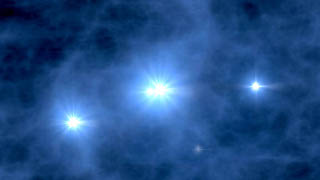Maybe you are wondering why anyone would want to understand cosmic chemical evolution. You might ask instead, What do we understand about GRBs? What are they? What can I learn about them? Or you can ask What can I learn with them?
It turns out any sort of light source, explosive or steady, is potentially a probe, and gamma-ray bursts are an excellent probe. If you have a very bright light originating shortly after the Big Bang – 13 billion year old light – all of that light has to propagate through the expanding Universe. It’s shining through the interstellar and intergalactic medium, which is absorbing certain wavelengths of energy and allowing others through. This is spectroscopy, which is important to astronomers for measuring an object’s chemical composition and its velocity.
First stars: An artist's concept of the first stars forming after the Big Bang. The first stars should have been supermassive and metal-poor, whose lives would end relatively quickly (in a few million years) with a collapsar and a GRB. However there is currently no observational evidence of these earliest GRBs.
Credit: NASA
The technology needed to do spectroscopy in the gamma-ray regime is rather different from what’s needed in the infrared and optical, but the basic idea is the same. When you take a spectrum, you look at how much happens in the blue and how much happens in the red. You want to get as much resolution as you can, you want to look at how much light you are getting, and you want to know how is it distributed over the energy scale or frequency scale or wavelength scale. That’s sort of the generic idea of all spectroscopy. Depending on the field you’re in, it’s either a challenge or a piece of cake.


